Benito Juarez Academy thriving under new academic system
By Kevin Beese Staff Writer — January 29, 2025
A Benito Juarez Academy student makes a chess move during an Activity Fair at the school in Chicago’s Pilsen neighborhood. Since going to a competency-based education system, the school’s students are excelling, according to the Juarez principal. (Juarez Academy photo)
Juan Carlos Ocon saw that traditional learning was not working at Benito Juarez Community Academy and did something about it.
The principal at the school in Chicago’s Pilsen neighborhood scrapped the standard A-to-F grading system and traditional learning in favor of competency-based education.
“The traditional system of education was not serving my students. It doesn’t serve students of color,” Ocon said. “Most of the traditional educational system serves 1 percent of students. It was clear it wasn’t working.”
Instead of class ranks, rote memorization, traditional deadlines and standard grading, Ocon implemented a grading system ranging from 1 (emerging) to 8 (excelling) and curriculum where students are co-designing what happens in the classroom.
“The traditional grading of A to F is based on seat time, not learning time,” Ocon said. “It is so flawed. You are having students sit at a desk in a school classroom for 300 minutes a day.
“The traditional system of education is an 18th century model still in place in the 21st century. It does not make any sense and yet we are still using the system. It was a system established not for high schools, but for the overtime pay of professors more than 100 years ago.”
In a traditional classroom, students may have until noon Friday to turn in a project. If they don’t, they receive a zero on the project. In the competency-based classroom, students have multiple opportunities to turn the project in for credit.
“Students learn at 5 a.m. and at 6 p.m. It is whenever that light bulb goes off,” Ocon said. “So, let’s build and design a system to accept when learning happens, not an 8 a.m.-3 p.m. school day.

Juan Carlos Ocon (University of Chicago photo)
“You never know when that light bulb is going to go off. Kids might get it when they’re up at 2 a.m. With CBE, we have 1:1 technology so that student can email a teacher or submit a project on Google Classroom and the teacher will give them credit. It is not just what happens between the hours of 8 a.m. and 3 p.m. It makes school look very different.”
Ocon has spent 24 years at Juarez, the last 17 as principal.
“This truly is my home,” he said. “The school itself and what it stands for means so much to me. Part of that went into CBE.”
Ocon said since the 2016 transition to competency-based learning to address students’ socioeconomic needs, Juarez has been on an upward trajectory.
“We are now a thriving neighborhood high school, a school of choice and a hub of activity in the Pilsen community,” Ocon said. “I am proud of the work we are doing.”
The Juarez principal said the numbers tell the story.
In 2018, only 50 percent of Juarez graduates went on to college. This past school year, 84 percent of Juarez students were accepted to college.
“There were not any issues or complications with college admission,” Ocon said of the academy’s nontraditional grading.
“CBE is more aligned with what colleges require of students to be successful,” he added. “We have a great partnership with colleges. Our students are focused on the competency skills necessary to succeed.”
Ocon said the nontraditional 1-8 grading scale is more reflective of where students are in their learning progression and the mastery of skills.
“It’s more meaningful feedback,” he said.
The Juarez principal said it took some time for stakeholders, most notably teachers, to buy into the competence-based education system
“Parents understand skill acquisition and want their students proficient in it. The cornerstones of CBE are synthesize, analyze and implement,” Ocon said. “That is what parents want from their children’s education.”
He said teachers were not against the education switch, just hesitant, not knowing all that it entailed.
“They were all trained at universities which teach the traditional system,” Ocon said. “All they knew was the A-to-F system and rote memorization. It did take them some time to buy into the transition, but when they understood it, they not only accepted the system but became cheerleaders of it
“We now have wall-to-wall competency-based education from PE to AP-level classes.”
kbeese@chronicleillinois.com






